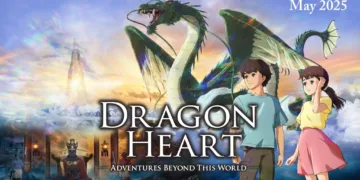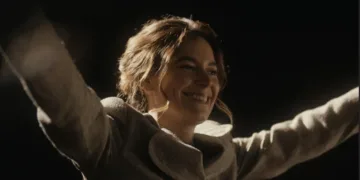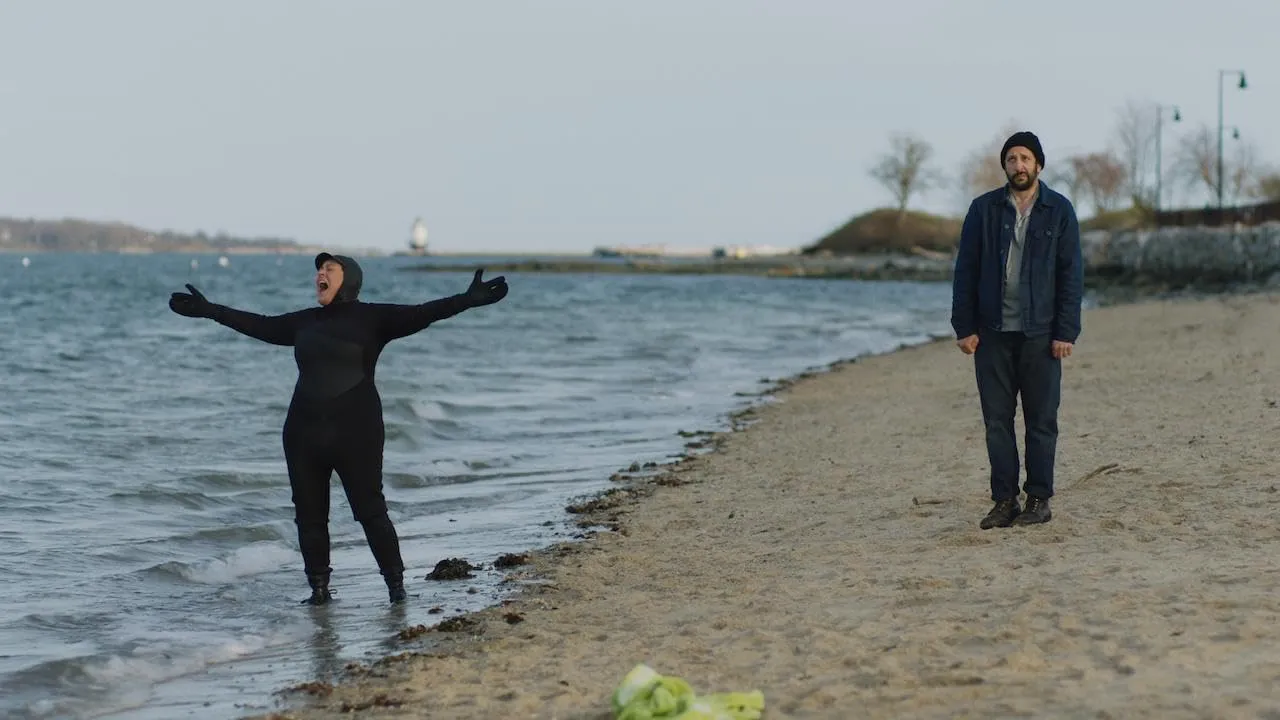In “Hangdog,” the narrative unfolds with Walt, an aspiring artist adrift in a sea of self-doubt and ennui, who finds himself in the quaint yet disorienting town of Portland, Maine. The initial incident—a moment of neglect where he loses his girlfriend Wendy’s beloved dog, Tony—serves as both a catalyst and a mirror.
This seemingly trivial event spirals into a chaotic quest that reveals the fragility of Walt’s identity and his fraught relationship with Wendy, characterized by her ambition and his inertia. Their dynamic is steeped in the complexities of modern love, where affection is often overshadowed by existential dread.
As Walt starts on a frantic search for Tony, his decision-making process is marred by impulsivity and desperation, reflecting the quintessential struggles of a man grappling with inadequacy. The following chaos—marked by encounters with an eccentric cast of Portland locals—illuminates his failings and the absurdity of his situation.
Wendy’s absence looms large, amplifying his already heightened anxiety and forcing a reckoning with his emotional landscape, a landscape littered with missed opportunities and unmet potential. The film deftly balances humor and pathos, showing that the journey is often as tumultuous as the destination in the pursuit of belonging and redemption.
The Melancholic Antihero of “Hangdog”
At the heart of “Hangdog” lies Walt, played with remarkable nuance by Desmin Borges. This character embodies a modern archetype: the melancholic antihero oscillating between self-deprecation and a desperate desire for connection. Walt’s emotional journey is a rich tapestry woven with threads of self-pity and indecisiveness.
His flaws are not merely obstacles but essential to his narrative arc; each misstep reveals layers of insecurity and a profound fear of inadequacy. The audience sees his internal struggle unfold, often in cringeworthy scenarios that compel sympathy and frustration. This duality—Walt’s charm coupled with his haplessness—sparks a compelling exploration of the modern male psyche, one that is often paralyzed by the weight of expectations.
In sharp contrast stands Wendy, brought to life by Kelly O’Sullivan. Her screen time is limited, but her presence looms big, illuminating Walt’s shortcomings. Wendy is a shining example of ambition and fortitude as she juggles her family’s needs with her work goals.
Her character counterbalances Walt’s immobility, highlighting the tension between personal growth and inertia in interpersonal relationships. Wendy’s initiative highlights Walt’s inactivity, inviting further consideration of the interactions between support and dependence in contemporary relationships. Her strength subtly criticizes Walt’s inability to step up, forcing him to confront both his failures and the results of his lack of action.
The narrative landscape is enhanced by the presence of supporting characters like Marianne and Brent, who provide moments of levity and understanding that help Walt change. Marianne serves as a mentor and a mirror for Walt, pushing him to confront the limits he sets for himself with her blend of tough love and wisdom.
Brent, the local who means well but isn’t sure what he’s doing, represents the quirks of small-town life and grounds Walt’s journey in the reality of community. Each interaction with these characters pushes Walt along his path of self-discovery, illustrating the film’s main idea: personal growth frequently results from our connections, no matter how flawed they may be. By encapsulating the messiness of life and relationships in all their disarray, “Hangdog” creates a rich, textured portrait of the human experience through them.
Navigating Identity in “Hangdog”
The tumultuous journey of its main character, Walt, is used to expertly weave a narrative of self-discovery in “Hangdog.” His initial self-doubt is palpable, reflecting a larger commentary on the existential crises that many people face in today’s rapidly changing landscape. The following chaos catalyzes introspection as Walt deals with the chaos of losing Tony, his girlfriend’s dog.
Every mishap he has, whether it be with strange locals or in moments of lonesome despair, pushes him closer to a deep understanding of who he is and his place in the world. There are many interesting characters along the way who challenge and inspire him, and his inner struggles also shape the journey. These interactions highlight the path to personal growth, from Marianne’s tough-love advice to Brent’s misguided tries, supporting the film’s claim that self-discovery is frequently a group effort.
The thematic landscape of the film is further enhanced by the complexities of Walt and Wendy’s relationship. Their relationship swings back and forth between affection and resentment, capturing the essence of contemporary relationships with unspoken expectations. Wendy’s ambition starkly contrasts Walt’s lack of progress, creating tension that mirrors societal narratives about gender roles and duty.
In Wendy’s search for her path, Walt’s failure to commit to her and his goals becomes a moving look at responsibility. The film skillfully moves between themes of talking and not talking, illustrating how silence between people can sometimes be more powerful than words. Through their interactions, the audience sees how fragile love can be when standards aren’t met, and there’s a fear of not being good enough.
Portland becomes a character in and of itself; it is both a safe place for Walt and a challenge for him. A microcosm of community life that is both encouraging and perplexing is presented by the city’s diverse population, which mirrors Walt’s own problems and hopes. The interdependence of individual journeys within the fabric of communal life is portrayed in “Hangdog,” which captures the nuanced reality of belonging.
In addition to influencing Walt’s quest, each character he encounters also captures the universal experience of looking for acceptance and understanding in a world that can sometimes feel strange. The film’s vivid picture of Portland makes the powerful point that true belonging isn’t just about physical space, but also about the relationships we build in that space. It reflects what home means in a world where people move around a lot.
Directing the Everyday: Cascella and Cordery’s Craft in “Hangdog”
Matt Cascella’s direction of “Hangdog” subtly shows how to tell a story by emphasizing character growth more than typical plot mechanics. His style skillfully strikes a balance between humor and pathos, inviting viewers into Walt’s crazy world while keeping an emotional core that hits home. Cascella has a keen eye for observation, capturing the absurdities of everyday life with a light touch that never goes into farce.
This careful balancing lets moments of levity coexist with the weight of Walt’s internal struggles, creating a dynamic narrative landscape where laughter and sadness flow together naturally. Each scene plays out with a sense of authenticity, reflecting the complexities of human relationships and the various ways people deal with their insecurities.
Jen Cordery’s script, which shines through its vivid dialogue and richly drawn character interactions, goes well with Cascella’s direction. Cordery writes conversations that sound natural and are often full of hidden meanings that reveal the characters’ true fears and desires. With its refreshingly honest tone, the screenplay captures the awkwardness and tenderness of Walt and Wendy’s relationship without using overused clichés.
Precision is used in the pacing to allow for introspection while moving the narrative along. Cordery’s writing encourages a deep investment in the characters’ journeys by allowing the audience to engage with them deeply. Cascella and Cordery work together to make a film that is as much about the silences between words as it is about the dialogue itself, crafting a rich exploration of love, loss, and the quest for belonging.
Framing Portland: The Visual Poetry of “Hangdog”
The emotional and thematic undercurrents of the film are expressed through Nathan Golon’s photography in “Hangdog,” which serves as a crucial lens. The visual style transforms the city into a character that pulsates with its own life, capturing Portland, Maine’s rugged charm. Goinglon’s use of natural light gives scenes a genuine authenticity, highlighting the contrast between the setting’s sweetness and the chaos in Walt’s life.
The camera frequently lingers on the textures of the setting, such as the worn-down facades, the busy streets, and the calm waterfront. Each shot is carefully put together to show Walt’s changing emotional state. This meticulous attention to detail creates a strong sense of place, inviting the audience to engage with Portland as more than just a background but an essential part of the narrative.
Golon’s choices about what to draw have more to do with Walt’s inner problems and growth than just representing them. With compositions that highlight Walt’s diminutive size in comparison to the vast landscapes and busy urban settings, scenes are often framed to mirror his isolation. Close-ups of the main character’s tiny expressions of despair and hope break up the scenes of introspection, making the main character’s inner turmoil clear.
Symbols, like the images of open places and closed doors that keep coming up, help Walt on his journey to find himself. The cinematography captures the tension between confinement and freedom, encapsulating the essence of his quest for belonging as he makes his way through the maze of his emotional landscape. Golon’s work transforms “Hangdog” from a straightforward narrative into a visually rich examination of the human state in this way.
The Sonic Landscape of “Hangdog”
The score for “Hangdog” by Walter Martin serves as an evocative undercurrent that enhances the film’s emotional resonance. The soundtrack skillfully blends silly melodies with moving themes, effectively highlighting Walt’s journey through fleeting joy and moments of despair.
Martin’s compositions gracefully support these changes in the narrative, creating a rich auditory experience that strengthens the audience’s connection to the characters as the narrative swings between humor and tragedy. The music brings the scenes to life, amplifying the danger of Walt’s mishaps and the tender moments of introspection. It serves as more than just a backdrop.
Additionally, the general sound design further immerses viewers in the world of the film by using background noises to set the scene in Portland. Walt’s experiences are enhanced by the lively sounds of the city, such as laughs, chatter in the distance, and the rustling of leaves. Together with the score, these sounds create a complicated soundscape that shows Walt’s inner struggles and the complexities of his interactions. The film’s study of identity, connection, and the search for belonging is enhanced by including sound as an integral part of the narrative.
The Heart of “Hangdog”: A Reflection on Life’s Absurdities
With its skillful weaving of themes of self-discovery, connection, and the complexities of modern relationships, “Hangdog” is a moving look at the human situation. The film basically sends a message about how important it is to deal with one’s weaknesses and the importance of community in managing the unpredictable landscape of life.
It encourages viewers to consider their own journeys, illustrating that the path to understanding oneself is often riddled with blunders and clarity moments. The narrative claims that growth is not linear but a series of twists and turns that can lead to deep insights, often found in the most unexpected places, through Walt’s mishaps.
For those who enjoy narratives that embrace the daily struggles of ordinary people, “Hangdog” has a lot of appeal as a slice-of-life comedy. Its blend of humor and heart creates an emotional connection that lasts long after the credits roll, making it a relatable experience.
The way Portland is portrayed in the film, along with its vibrant absurdities, weaves a rich tapestry that is both specific and general, putting the character of life in a familiar context. “Hangdog” can connect with a wide audience because it has relatable themes and real humor, inviting both laughter and thought. The film serves as a gentle reminder of the importance of love, community, and the beautiful messiness of being human in a time of fast change and disconnection.
The Review
Hangdog
With humor and moving reflections on relationships, "Hangdog" is a heartfelt study of self-discovery. Jen Cordery's screenplay and Matt Cascella's direction weave together a rich tapestry of characters dealing with life's absurdities. Nathan Golon's cinematography and Walter Martin's evocative score add to the emotional depth. In a relatable and interesting way, this slice-of-life comedy captures the complexities of human connection and the search for belonging.
PROS
- Engaging character development that fosters empathy.
- A balanced blend of humor and emotional depth.
- Vivid cinematography that captures the essence of Portland.
- Strong performances from the cast, enhancing relatability.
- Thoughtful screenplay with sharp, witty dialogue.
CONS
- Pacing may feel uneven at times.
- Some secondary characters could benefit from further development.
- Certain plot points may seem familiar or predictable.





















































